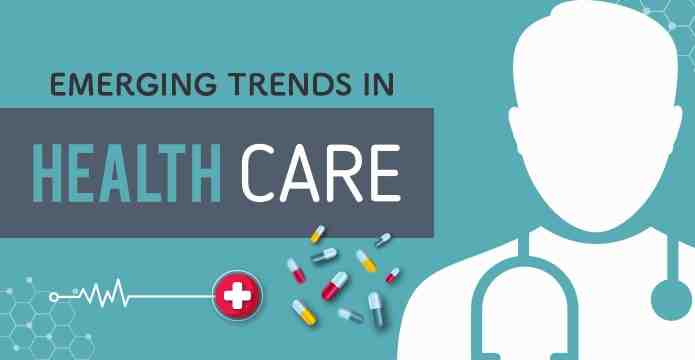As we wait to see what the coming year will bring, now is a great time to look at what is currently going on in the world of healthcare. Many of the trends that we see today may be predictors of what is coming in the near future. Can you guess what will be next?
Here are seven current trends in healthcare that are shaping the industry
1. Getting social
Did you ever think you’d live to see healthcare leverage the power of social media? It’s true that this industry lags way behind others on this front, but it is catching up and seeing some major advantages. Not only are healthcare providers and brands becoming more active on social channels, with 60% of doctors reporting that social media helps improve their quality of care, but organizations have also begun using tools to reach out to the community. Small things can have a big impact on overall health, so if organizations can reach people at their level to ensure they’re taking medications correctly and eating healthy diets, everyone wins.
2. Putting patients first
Remember the old days when you had to wait an hour before the doctor would see you? You’d show up for your 12 o’clock appointment 10 minutes early and end up waiting until 12:45 before they even put you in a room. Maybe it didn’t always happen, but it used to be more the norm than it is today. Today, healthcare is more consumer-oriented than ever before. Patients can compare doctors and hospitals as easily as they can browse through restaurants on Yelp. This trend has caused everyone in the industry to up their game.
3. Digitalization of healthcare
In this industry, we’ve been talking about a digital transformation for quite some time. It’s finally coming to fruition, and we only expect that it will get better. New technologies, such as patient-focused Customer Relationship Management (CRM) solutions have helped improve patient satisfaction and the overall level of care. This data aggregation may also help organizations cut costs by identifying and treating patients’ health issues sooner. For example, real-time data analytics can give doctors a snapshot of a patient’s health that can lead to early intervention instead of advanced disease treatment.
4. Telemedicine
Telemedicine is another area of growth that we’ve been buzzing about around the water coolers for ages, but it has seen some amazing growth in the past couple of years. In 2017, we saw large healthcare organizations start using telemedicine to help them expand. In the past, organizations most often used telemedicine for pilot projects, but we’re beginning to see it integrated into regular practice. Hospitals like Copper Queen Community Hospital in Bisbee, Arizona have integrated telemedicine to treat patients in its rural areas. Implementations like these are exciting for everyone in the healthcare industry and patients alike.

5. Addiction treatment
With a growing and concerning number of addiction cases, we cannot fully address the state of healthcare without mentioning addiction. Although funding is still somewhat uncertain, we can be sure that addiction treatment will continue to be a large focus in the healthcare industry. Family practitioners today are more educated on the signs and symptoms of addiction, and prescriptions for addictive drugs are slowly beginning to decline. Unfortunately, this isn’t a problem we’ll see go away soon, but we can only hope to see some relief for this nationwide crisis. The healthcare industry is changing to become more social and patient-driven, and it will be exciting to see what new trends emerge in 2018 and beyond.
6. mHelth; accelerating trend in healthcare
Three major trends already happening in healthcare lend themselves to the revolution in mobile technology:
- Ageing population: Ageing populations and chronic illness are driving regulatory reform. Public sector healthcare is seeking better access and quality, and it’s looking to the private sector for innovation and efficiency. mHealth improves access and quality and offers dramatic innovation and cost reduction.
- Foundations already in place: The foundations of industrialisation of healthcare are already in place — electronic medical records, remote monitoring and communications. ‘Care anywhere’ is already emerging. The platform for mHealth is set.
- Personalisation: Healthcare, like other industries, is getting personal. mHealth can offer personal toolkits for predictive, participatory and preventative care.
7. Comprehensive chronic care
Chronic diseases and conditions are on the rise worldwide. An ageing population and changes in societal behaviour are contributing to a steady increase in these common and costly long-term health problems. The middle class is growing; and with urbanisation accelerating, people are adopting a more sedentary lifestyle. This is pushing obesity rates and cases of diseases such as diabetes upward. According to the World Health Organization, chronic disease prevalence is expected to rise by 57% by the year 2020. Emerging markets will be hardest hit, as population growth is anticipated be most significant in developing nations. Increased demand on healthcare systems due to chronic disease has become a major concern.
Another rising health concern is global pandemics. The pandemics of the past decade have clearly demonstrated the speed at which infections spread across the globe. Ebola, SARS, MERS, and H1N1—to name but a few—demand coordinated and agile healthcare responses. Pandemics will in all likelihood exert periodic and significant disruptive pressure on health systems. Healthcare organisations across the globe need to be ready to work together to contain outbreaks quickly when they occur.









